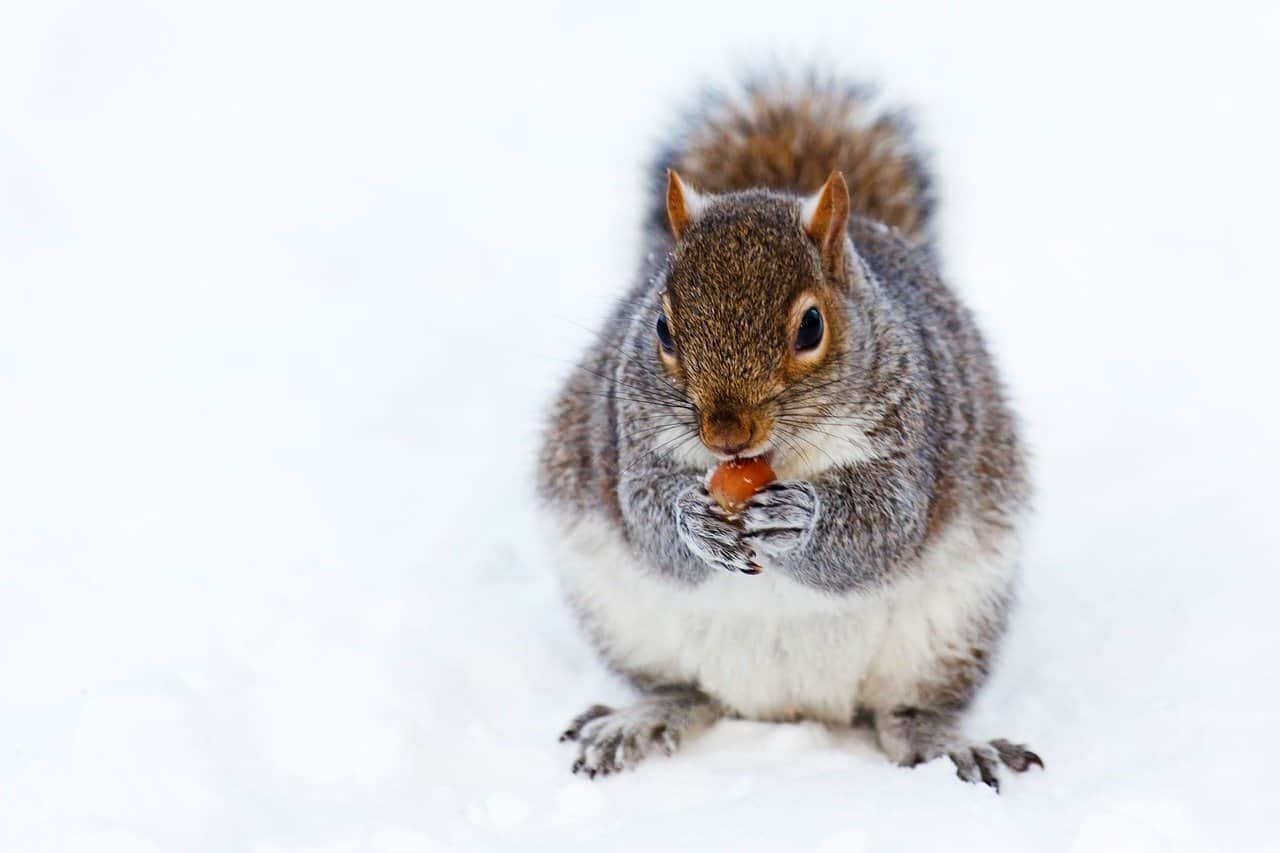As the temperatures start to drop, and the last leaves of fall are gone, you may notice squirrels busy gathering food to prepare the cold months ahead.
Squirrels do not hibernate over the winter months, so they plan ahead for their survival by storing and burying food to help themselves get through the cold weather, when there is less food for them to find during the three to four hours they are active each day.
Storing Nuts
Squirrels will collect acorns, walnuts and other available food and either store them in their nests or bury them, usually about an inch underground. This is so other squirrels won’t find them and they can come back when that food is needed. While it may seem completely random where a squirrel buries its food, in truth there is a method to the madness. Studies done on tagged squirrels at the University of California Berkeley and at the University of Pennsylvania found that squirrels bury similar types of nuts together. This is a type of memory technique identified as “spatial chunking” based on the size, type and value of the nuts. (add picture of squirrel sniffing on lawn)
When the squirrel needs to find the nuts again it can go back to the area and will relocate the buried nuts for that cache category using their sense of smell. And during this time of storing up food, squirrels have strategies to make the food last as long as possible. Squirrels may crack the shell on a nut so that the nut will not begin to germinate. And to deal with opportunistic competitors, squirrels may dig a hole and then pretend to drop in a nut to mislead any watching rivals.
Keeping Warm in Winter Nests
Squirrels that are active may have two or three nests as they will travel over an area greater than 5 acres to look for food. With multiple nests that is also more room to store up food for the winter. Squirrels typically nest alone during the winter, although as they begin mating in January and February, a mating pair may share a nest for a short time. And if the weather is particularly cold, squirrels may share a nest to help each other keep warm to survive.
The two main types of squirrel nests are leaf /twig nests and hollows in trees. When fall comes it is easier to see squirrel nests that have been built in the trees. (add Picture) And it is easy to tell them from bird nests as they are much larger, some up to 24 inches wide. Hollows in trees are the result of woodpeckers or can come from lost tree limbs and natural decay of older trees. Nest in tree hollows (add pciture) can offer better protection from bad weather but can be harder for squirrels to find in areas with well maintained trees or fewer mature trees. Squirrels are active during the daytime (diurnal) and will usually start leaving the nest near dawn in the wintertime to look for or retrieve food. This activity may only last for several hours and by the middle of the day they return to their nest for warmth and rest.
Feeding Squirrels in Winter
If you want to help your local squirrels survive the winter months, you can help them to find food easily as well as provide high calorie food that will keep them able to warm themselves. Typically people try to avoid allowing squirrels to raid birdfeeders because they take most of seed and keep birds from using the feeder while they are getting their fill. But in winter if you have a birdfeeder that you can use with seeds for squirrels you can help make the squirrels food cache last longer with a supply of seed or nuts. Loading up the birdfeeder with black oil sunflower seeds will definitely get the attention of local squirrels and the oil in these seeds are a good energy source. If you are also feeding birds that stay for the winter it may be a good idea to separate the feeder for the squirrels to use so everyone can get some nourishment over the cold months.
A wreath style feeder (picture) works particularly well for putting nuts out for squirrels and larger birds such as cardinals, woodpeckers and blue jays. This feeder will not typically attract smaller birds and is a good choice for a dedicated feeder for squirrels. The wire wreath feeders also won’t be chewed through by squirrels trying to get to the food.
High Calorie Treat
Suet is also a good option for winter feeding. Prepared suet blocks can be used and hung in a suet feeder, which is usually a coated metal wire cage. If you are going to set this out for squirrels make certain that the suet cage is strong because squirrels climbing on the cage, and chewing and pulling on the suet can damage a weak wire cage.
Suet blocks are available from many stores and they come in a variety of flavors. You can make your own suet blocks with a few simple ingredients. Traditionally suet is rendered beef fat mixed with your choice of seeds, oats, pieces of fruit and nuts. You can make an easy version by using shortening instead of the beef fat. The Audubon Society recommends the recipe below.
Ingredients:
1 ½ cups shortening (avoid shortening with palm oil it will melt or soften in warmer weather)
¾ cup any kind of nut butter
3 ½ cups of wild bird seed
1 cup of rolled oats
½ cup of corn meal
You will mix the dry ingedients of bird seed, oats and corn meal together first. Then set that aside as you prepare the shortening and nut butter. Combine the shortening and nut butter in a microwave safe bowl and melt in the microwave. Use full power of the microwave in 30 second increments. As the shortening melts, stir the mixture to blend in the nut butter. It may take a few minutes to get a smooth, uniform mixture. Once the shortening and nut butter blend is ready, add the mixture of seeds, oats and corn meal to the bowl. The suet mixture will become quite thick very quickly so stir with a sturdy wooden spoon.
Depending on the suet feeder you will use, you can transfer the suet to a plastic container that is similar in size (usually about 5 x 5 inches and 1 inch thick) to the suet feeder and then freeze the mixture. Another option is to spread the suet on a baking sheet that has an edge about 1/2 inch tall. Once the suet has hardened blocks can be cut out for the feeder.
After the suet is solid, about 2 hours, it can be transferred to a suet cage and placed outside. If you would like to make smaller portions you can get a silicone ice cube tray and make blocks of suet that can be placed in the suet cage, or if you plan to use the wreath style nut/suet feeder you can prepare as many blocks of suet as you need to fill the feeder.

